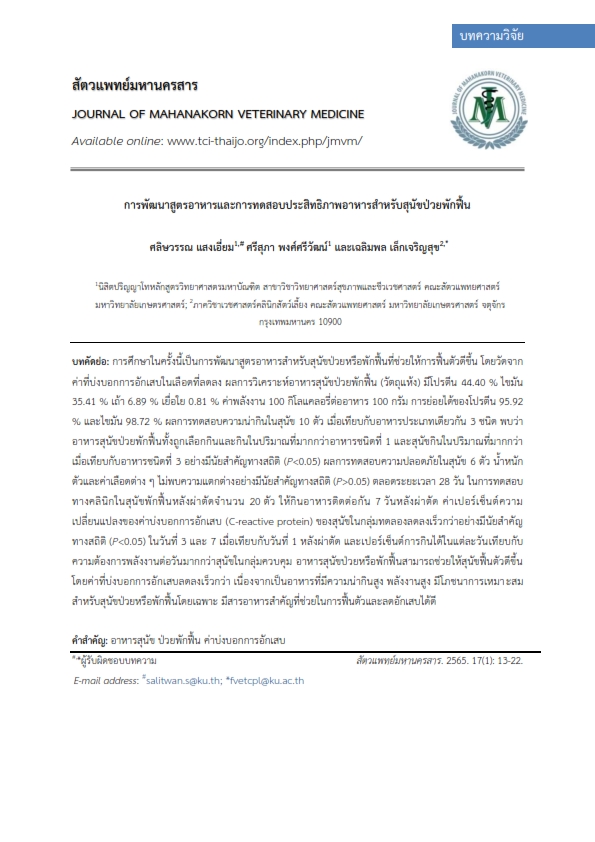Development of Dietary Formulation and Efficacy Test for Convalescent Dogs
Main Article Content
Abstract
The study objective was to create a new formulated diet to support recovery dogs by lowering C-reactive protein (CRP) concentration. Formulated diet has protein 44.40 %, fat 35.41 %, ash 6.89 %, and fiber 0.81 % in dry matter basis. Metabolizable energy 100 Kcal/100 g diet. Protein and fat digestibility were 95.92 % and 98.72 %, respectively. Palatability in 10 dogs, compared with 3 commercial convalescent diets. The formulated diet had higher preference and food intake than diet 1 with statistically significance (P<0.05), and food intake was more than diet 3 (P<0.05). Safety test from 6 healthy dogs within 28 days, their body weight and blood results were not statistically significance (P>0.05). In clinical trial of 20 dogs after surgery in 7 days, Percentage changes of CRP were lower statistically significance (P<0.05) in the treatment group than in the control group on day 3 and day 7 after surgery. Moreover, the percentage of food intake in treatment group each day was more than the control group. The formulated diet can help to improve the recovery phase in convalescent dogs by rapidly decreasing CRP concentration due to high palatability, high energy, and appropriate nutritional support for recovery and decreasing inflammation.
Article Details

This work is licensed under a Creative Commons Attribution-NonCommercial-NoDerivatives 4.0 International License.
References
Bauer, J. E. 2011. Therapeutic use of fish oils in companion animals. JAVMA. 239(11).
Biagi G., Mordenti A. L., Cochi M., and Mordenti A. 2004. The role of dietary omega-3 and omega-6 essential fatty acids in the nutrition of dogs and cats: A review. Progress in Nutrition, 6.
Burri L., Wyse C., Gray S. R., Harris W. S., and Lazzerini K. 2018. Effects of dietary supplementation with krill meal on serum pro-inflammatory markers after the Iditarod sled dog race. Res. Vet. Sci. 121: 18-22.
Ceron, J.J., Eckersall, P.D., and Martýnez-Subiela, S. 2005. Acute phase proteins in dogs and cats: current knowledge and future perspectives. Vet. Clin. Pathol. 34: 85–99
Chan, D., Rozanski E., and Freeman L. 2009. Relationship among plasma amino acids, C‐reactive protein, illness severity, and outcome in critically ill dogs. J. Vet. Intern. Med. 23: 559–563.
Chan, D. 2015. Estimating energy requirements of small animal patients, p. 7-13. In, eds. Nutritional management of hospitalized small animals. Wiley Online Library.
Dust J. M., Grieshop C. M., Parsons C. M., Karr-Lilienthal L. K., Schasteen C. S., Quigley J. D., Merchen N. R., and Fahey Jr. G. C. 2005. Chemical composition, protein quality, palatability, and digestibility of alternative protein sources for dogs. J. Anim. Sci. 83: 2414–2422.
Eckersall P. D. and Bell R. 2010. Acute phase proteins: Biomarkers of infection and inflammation in veterinary medicine. Vet. J. 185(1): 23-27.
Kanno N., Hayakawa N., Suzuki S., Harada Y., Yogo T., and Hara Y. 2019. Changes in canine C-reactive protein levels following orthopaedic surgery: a prospective study. Acta. Vet. Scand. 61(1): 33.
Kathryn E. M. 2015. Nutritional assessment in small animals. In D. a. Chan (Ed.), Nutritional management of hospitalized small animals (pp. 1): John Wiley & Sons, Ltd.
Kilburn L. R., Allenspach K., Jergens A. E., Bourgois M. A., Mochel J. P., & R., S. M. C. 2020. Apparent total tract digestibility, fecal characteristics, and blood parameters of healthy adult dogs fed high-fat diets. J. Anim. Sci. 98(3).
Kum C., Voyvoda H., Sekkin S., Karademir U., and Tarimcilar T. (2013). Effects of carprofen and meloxicam on C-reactive protein, ceruloplasmin, and fibrinogen concentrations in dogs undergoing ovariohysterectomy. Am. J. Vet. Res. 74: 1267–1273.
McDaniel J. C., Belury M., Ahijevych K., and Blakely W. 2008. Omega-3 fatty acids effect on wound healing. Wound Repair Regen. 16(3): 337-345.
Serin G. and Ulutas P. A. 2010. Measurement of serum acute phase proteins to monitor postoperative recovery in anoestrous bitches after ovariohysterectomy. Vet. Rec. 166(1): 20-22.


